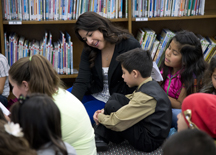Program helps Spanish-speaking children learn family language
December 3, 2012
 |
|
Ariana Diaz is one of 14 Purdue
students who are helping 55 Spanish-speaking children in Indiana learn how to
spell and read their native language as part "Aprendiendo a Leer," or
Learning How to Read, a weekly afterschool Purdue University program. The
research and engagement program, led by Alejandro Cuza, an assistant professor
of Spanish and linguistics in the School of Languages and Cultures, pairs the
Purdue students with groups of students in kindergarten through fourth grade at
Lafayette's Wea Ridge Elementary School and Frankfort's Suncrest Elementary
School. Each week they work on phonological skills and vocabulary learning to
develop reading ability. (Purdue University photo/Mark Simons) |
WEST LAFAYETTE, Ind. — Spanish-speaking children in Indiana are learning how to spell and read their native language as part of a Purdue University research and community project to help students improve their bilingual skills and ultimately achieve academic success.
"A number of children grow up speaking Spanish at home but never learn to read or write it until later in life, and we are evaluating how encouraging these children to be bilingual at a young age will improve their overall academic skills," said Alejandro Cuza, an assistant professor of Spanish and linguistics in the School of Languages and Cultures. "These children are born and raised in the United States and naturally focus on learning English, but studies show that being bilingual helps children achieve higher levels of cognitive development, including better problem-solving skills and working memory.
"They also learn to appreciate and have pride in their native language and culture, and improving their Spanish can reinforce family ties with relatives who predominantly speak Spanish."
"Aprendiendo a Leer," or Learning How to Read, is a weekly afterschool program that runs October through March. Fourteen Purdue students, some of whom are heritage Spanish speakers, work with 55 students in kindergarten through fourth grade at Lafayette's Wea Ridge Elementary School and Frankfort's Suncrest Elementary School. Each Purdue student works with a small group of children for an hour on phonological skills and vocabulary learning to develop reading ability. The vocabulary lessons focus on Spanish words that these children are not likely to learn at home but that are still meaningful to them. Each week there also is a cultural component that includes the reading and singing of children's music.
At the end of the 18 weeks, the students will be evaluated to see if there are improvements in their English and Spanish literacy skills. Both programs will be compared to a control group in Indianapolis. The findings could help develop future curriculum or programs to serve the large number of Spanish-speaking people in the United States. Six percent of the Indiana population speaks Spanish, and there are more than 50 million Spanish speakers in the United States.
 |
|
Alejandro Cuza |
"Similar research has been conducted with older Spanish-English bilingual children, but we want to examine what difference it makes when children are encouraged to be bilingual from a very early age," said Cuza, who specializes in second language acquisition and bilingualism. "If instruction takes place when they are younger, then they can focus on linguistics and literature in high school rather than learning the ABCs in Spanish. This will better help prepare them for college and, ultimately, their careers."
There are cases where the parents of these children are not very proficient in English, the language, which their children learn, and that can be an obstacle for children through their school years.
"Not being able to speak the family language might lead to a communication breakdown with the parents which could contribute to the child not doing well at school," Cuza said. "Over the long term, we want to see how these students perform in school."
The college students also become role models for these children, and by interacting with Purdue students who speak Spanish like them, Cuza said, they realize how they, too, can be successful in school and college.
Cuza and graduate student Lauren Miller oversee the weekly sessions, and the curriculum was designed by the research team. The project is funded by the Kinley Trust Foundation and Purdue Office of Engagement. A pilot program was tested last spring at Delphi Community Elementary School.
Purdue's program is in partnership with researchers from the Ontario Institute for Studies in Education at the University of Toronto, who are conducting a similar program focusing on heritage Chinese- and French-speaking students.
Writer: Amy Patterson Neubert, 765-494-9723, apatterson@purdue.edu
Source: Alejandro Cuza, acuza@purdue.edu
